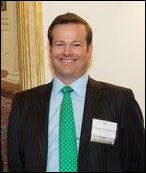By Pam Martens and Russ Martens: March 29, 2016
There were a lot of sweaty palms on Wall Street yesterday. As the Government Accountability Office released a report suggesting that regulation of Wall Street is a complex maze of inefficiency and fragmentation leaving gaping holes in which crooks can find fertile ground, the U.S. Justice Department was perp-walking a 2002 Harvard Law School graduate (whose family name resides on the student center there) on charges reminiscent of a Bernie Madoff startup.
According to the unsealed complaint from the U.S. Justice Department’s regional U.S. Attorney’s Office for the Southern District of New York, 39-year old Andrew Caspersen, whose father and grandfather were the former heads of Beneficial Corp., is alleged to have defrauded approximately $24.6 million from a charitable foundation by setting up a fake account, transferring $17.6 million of that amount to his “personal brokerage account” at an unnamed brokerage firm, then churning the hell out of options on the S&P 500 Exchange Traded Fund (SPY), which racked up losses of $14.5 million. What else Caspersen traded is not mentioned, but the complaint notes that as of December 31, 2015, his personal brokerage account had a “net loss of approximately $25 million.”
The Justice Department is calling this a $95 million fraud because on top of the $24.6 million that was defrauded from the charity, Caspersen attempted to obtain “an additional $20 million investment from the same charitable foundation and a $50 million investment from another multinational private equity firm headquartered in New York,” ostensibly to cover up the first fraud in a Ponzi like operation when the charity demanded its first $25 million back. Caspersen failed to obtain the additional sums.
The sweaty palms on Wall Street stem from the fact that some very big names are involved here. While the fraud was taking place, Caspersen was a managing director at PJT Partners Inc., whose largest shareholder is Blackstone Chief Executive Stephen Schwarzman. PJT trades on the New York Stock Exchange and the shares tanked yesterday on the news of Caspersen’s arrest, initially dropping as much as 24 percent before closing down a little over 10 percent.
A major law firm, Paul Weiss Rifkind Wharton & Garrison – the firm that has serially represented Citigroup over fraud charges – was brought in by PJT to investigate the matter according to Bloomberg News.
But the biggest bombshell comes from the related complaint brought by the Securities and Exchange Commission against Caspersen. One of the four largest banks in the U.S., Bank of America, was where Caspersen set up the fake investment account, wired $25 million into it and then transferred $17.6 million out of it into his own personal brokerage account according to the Justice Department complaint.
That should simply not have happened at a major U.S. bank. It raises serious questions as to (1) why Bank of America’s compliance staff were asleep at the switch; (2) what was the name of the brokerage firm that received the funds and why did they violate longstanding procedures and accept funds from a corporate named account into a personal named account; (3) was the matter referred to the U.S. Treasury’s Financial Crimes Enforcement Network (FinCen) office that investigates money laundering; (4) why is the Justice Department withholding from the public the names of all the firms and people involved, other than Caspersen; and (5) why did the U.S. Attorney’s Office put Kurt Hafer in charge of the case, when he’s only been with the Justice Department for less than two months?
The SEC’s complaint fills in a few of the cryptic details in the Justice Department complaint as follows:
“When Caspersen created his LLC, he deceptively named it Irving Place III SPV, so that others would deem it affiliated with Irving Place Capital Partners III SPV, a legitimate private equity fund not associated with Caspersen. Unlike Irving Place Capital Partners III SPV, Irving Place III SPV had no legitimate business. Rather, Irving Place III SPV is only a vehicle to solicit money from investors, and its only asset is a bank account controlled by Caspersen.
“To facilitate this offering, Caspersen drafted a promissory note and a security agreement, and he apparently signed these documents on behalf of Irving Place III SPV using the fictitious name, John Nelson. The note and agreement memorialized the offering terms of the investment that Caspersen had solicited from Investor 1. On November 5, 2016, Investor I made its $25 million investment using wire instructions provided by Caspersen, and transferred the $25 million to Irving Place III SPV’s bank account at Bank of America, an account controlled by Caspersen.”
Instead of providing the name of the brokerage firm where Caspersen then transferred the $17.6 million into his personal trading account, the SEC says only this: “Caspersen thereafter simply took control of these funds for his personal use.” (Bank of America owns the large brokerage firm, Merrill Lynch, and it is important for the public to know if that’s the brokerage firm where the illicit funds were transferred, or, the name of the outside brokerage firm where the funds went.)
The Justice Department’s complaint also neglects to provide the name of the brokerage firm that took corporate-name money into a personal-name account, but provides the following detail:
“…on or about November 6, 2015, and shortly thereafter, Caspersen sent wire transfers from Account-1 in a total amount of approximately $17,610,000 (‘Wires-2’) to Caspersen’s personal brokerage account (‘Account-4’) at a financial services corporation (the ‘Brokerage’).”
The Justice Department complaint also suggests that someone at the unnamed brokerage firm got suspicious of dubious dealings around December 2, 2015. It informed Caspersen that it was going to close the account and gave him just two days to remove the remaining assets. The question is, did that brokerage firm file a Suspicious Activity Report (SAR) with FinCen.
What Caspersen was engaging in has a familiar ring to what Bernie Madoff was doing with Norman F. Levy during the heyday of his Ponzi scheme: transferring large sums of money from the Madoff corporate account at JPMorgan into Levy’s personal account with JPMorgan failing to file Suspicious Activity Reports with FinCen. (See our in-depth report on that matter below.)
So the final question is, how long will Americans continue to tolerate the SEC and Justice Department denying the public a full accounting of what’s going on in those well-heeled and well-protected mahogany corridors of Wall Street?
Related Article on Money Laundering:
Bombshell Documents Vanish in the JPMorgan-Madoff Investigation



